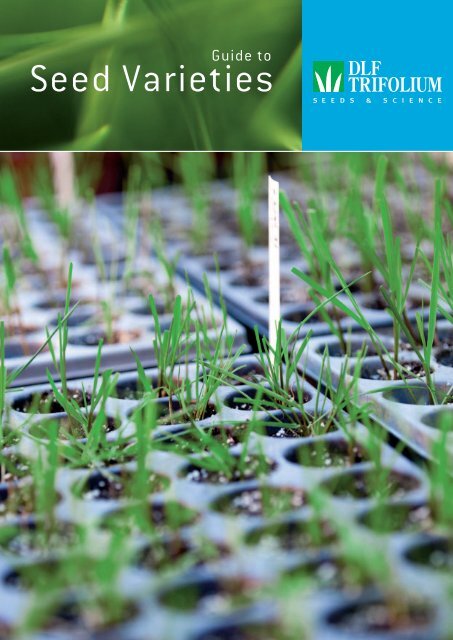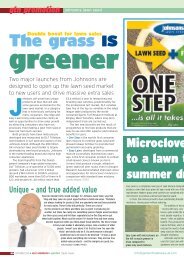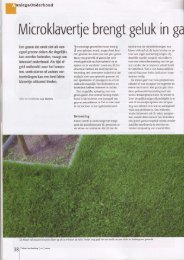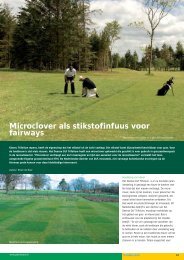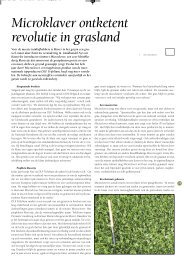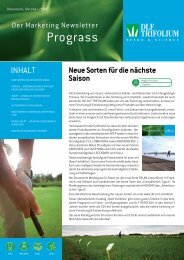Seed Varieties - dlf-trifolium
Seed Varieties - dlf-trifolium
Seed Varieties - dlf-trifolium
Create successful ePaper yourself
Turn your PDF publications into a flip-book with our unique Google optimized e-Paper software.
Guide to<br />
<strong>Seed</strong> <strong>Varieties</strong>
Forage <strong>Varieties</strong><br />
How to read the ratings<br />
The main features of each species are rated. This gives you<br />
an overview of the main characteristics of each specific<br />
variety. The rating is marked with a red dot and there are<br />
nine different positions. The more to the right, the higher<br />
the score in the described feature. The varieties are<br />
mentioned in alphabetical order and some species are also<br />
divided into diploid and tetraploid sections.<br />
NEW<br />
NEW<br />
NEW<br />
Means that it is a new variety that has been listed.<br />
VARIETY PLOIDY LATENESS<br />
Red Clover (Trifolium pratense L.)<br />
Red Clover thrives well in a wide range of soils except very light,<br />
acidic or water-logged soil. It has a deep root system which makes<br />
it drought tolerant. Red Clover is an important component of clover/<br />
grass mixtures for one or two year conservation leys.<br />
5<br />
Regarding rating of lateness; most forage species in this<br />
edition have relative figures for lateness (ear emergence).<br />
The scale goes from 1-12 and is the same for all species,<br />
enabling comparison between species.<br />
Please also visit www.<strong>dlf</strong>.com for more information about<br />
species and varieties. Here you will find product leaflets<br />
with detailed information on our varieties.<br />
If you have any questions to availability or ordering, please<br />
do not hesitate to contact your DLF sales person.<br />
LISTED/<br />
RECOMMENDED IN<br />
PAVO D 5 A,CH,CZ,D<br />
RAJAH D 8 BY,EST,HR,LV,S,SI,ZA<br />
SUEZ D 7 CH,CZ,F<br />
VENDELIN D 7 CZ,F<br />
AMOS T 7 A,BY,CZ,F,S,SK,UK,ZA<br />
BESKYD T 7 A,CZ,I,SK<br />
BIVOJ T 7 CZ<br />
DOLINA T 7 B,BY,CA,CZ,DK,LU,NL,PL,UK<br />
FRESKO T 7 CZ<br />
KVARTA T 7 A,CZ,D,SK<br />
LONE T 8 FI,N<br />
MARO T 6 D,EST<br />
NODULA T 7 CZ<br />
REZISTA T 7 CZ<br />
VESNA T 5 CA,CZ,EST,HR,LIT,RO,RU,SK<br />
WINTER<br />
HARDINESS<br />
Lowest score of character Highest score of character<br />
RED CLOVER<br />
YIELD<br />
In most countries with a temperate climate, Red Clover is widely<br />
cultivated and tolerates low temperatures during winter. The<br />
tetraploid varieties are more vigorous and leafy in growth.
NEW<br />
6 Forage <strong>Varieties</strong><br />
VARIETY<br />
LISTED/<br />
RECOMMENDED IN<br />
AVOCA IRL,UK<br />
CHIEFTAIN F,IRL,UK<br />
GALWAY UK<br />
IONA UK<br />
KLONDIKE A,BY,D,DK,EST,F,RU,UK<br />
MILAGRO DK,F<br />
PEPSI CH<br />
RABBANI A,CH,D<br />
RIESLING A,B,CZ,D,F,LIT,LV,NL,PL,UK<br />
RIVENDEL BY,D,DK,EST,F,HR,LIT,NL,RU,SI,SK,UK<br />
RONNY EU<br />
SILVESTER DK<br />
TRIPLE D,F<br />
VIOLIN D,UK<br />
* HCN = Hydrogen cyanide<br />
White Clover (Trifolium repens L.)<br />
White Clover thrives very well in soils with good water capacity.<br />
The yield on sandy soils is very high provided there is sufficient<br />
moisture from rainfall or irrigation. White Clover is more persistent<br />
than Red Clover and forms many new shoots from the stolons.<br />
Winter hardiness is good.<br />
LEAF SIZE<br />
CLOSE GRAZING<br />
TOLERANCE<br />
WHITE CLOVER<br />
YIELD<br />
Lowest score of character Highest score of character<br />
HCN<br />
CONTENT *<br />
White Clover in grassland increases palatability and intake of cattle<br />
significantly. Digestibility, including flowerheads, is very high. The<br />
small leaved varieties are well suited for grazing whereas the large<br />
leaved types can be used for conservation as well.<br />
–
NEW<br />
VARIETY<br />
DORMANCY<br />
LEVEL<br />
Forage <strong>Varieties</strong><br />
LISTED/<br />
RECOMMENDED IN<br />
CRENO 4 LIT,PL<br />
DAISY 4 BY,DK,EST,F,HR,LV,NL,RO,SI,TR,UK<br />
RELAX 4 A<br />
VELA 4 PL,UK<br />
Lucerne/Alfalfa (Medicago sativa L.)<br />
Alfalfa is grown in most temperate regions of the world. It thrives<br />
very well on well-drained soils with a sufficient content of lime,<br />
potash and phosphate. It has a deep tap root system and is thus<br />
able to withstand severe drought. It is a productive plant with high<br />
nutritional value. It has an early spring growth and rapid regrowth<br />
Alsike Clover (Trifolium hybridum L.)<br />
Alsike has growth characteristics of both Red and White Clover. It<br />
thrives well in acidic and water-logged soils and is used in mixtures<br />
with grasses suitable for these conditions. The persistence of the<br />
clover is normally 2-3 years.<br />
Black Medick (Medicago lupulina L.)<br />
Black Medick is mainly used for intercropping for green manuring.<br />
The crop is undersown in a spring cereal and is ploughed under in<br />
NEW<br />
VARIETY SPECIES<br />
WINTER<br />
HARDINESS<br />
LUCERNE/ALFALFA<br />
PROTEIN<br />
CONTENT<br />
YIELD<br />
after cutting. Alfalfa can be conserved as hay but it is also possible<br />
to ensile the crop by mixing it with grasses, alternatively it can also<br />
be utilised by drying it artificially and making it into pellets. Alfalfa<br />
is divided into dormancy groups that refer to autumn growth after<br />
the last cut.<br />
LISTED/<br />
RECOMMENDED IN<br />
LOTANOVA Birdsfoot Trefoil (Lotus corniculatus) CA,EST,I<br />
ERMO ØTOFTE Alsike Clover (Trifolium hybridum) DK,JP<br />
VIRGO Black Medick (Medicago lupulina) DK<br />
VARIETY LATENESS<br />
Dormancy 1-9: 1 = very dormant, 9 = non dormant Lowest score of character Highest score of character<br />
LISTED/<br />
RECOMMENDED IN<br />
ABOSAN 1 6 D,NL<br />
ALUTUS 5 F<br />
ASTURION 7 F,NL<br />
BOVINI 7 B,F,NL<br />
BOYNE 4 D,DK,PL,UK<br />
BREE 4 D,NL,UK<br />
BURLINA 1 6 NL<br />
BUTARA 1 5 UK<br />
CALVANO 1 4 NL,UK<br />
CANCAN 8 B,D,IRL,LU,UK<br />
PERSISTENCY<br />
WINTER<br />
HARDINESS<br />
OTHER LEGUMES<br />
PROTEIN<br />
CONTENT<br />
Lowest score of character Highest score of character<br />
YIELD<br />
the late autumn or following spring. Black Medick is used for forage<br />
as well.<br />
Birdsfoot Trefoil (Lotus corniculatus L.)<br />
Birdsfoot Trefoil thrives well in drought-prone and less fertile soils<br />
due to the deeper tap roots. It produces high quality forage and the<br />
content of tannins prevents bloating in grazing cattle. It is normally<br />
shorter lived than White Clover.<br />
RUST<br />
RESISTANCE<br />
SPRING<br />
GROWTH<br />
DIPLOID PERENNIAL RYEGRASS<br />
WINTER<br />
HARDINESS<br />
GROUND<br />
COVER<br />
Lowest score of character Highest score of character<br />
YIELD<br />
9
10 Forage <strong>Varieties</strong><br />
NEW<br />
NEW<br />
NEW<br />
NEW<br />
NEW<br />
VARIETY LATENESS<br />
LISTED/<br />
RECOMMENDED IN<br />
CHIFORD 1 6 F<br />
COMPLOT 6 B,F<br />
DEFENDER 5 F<br />
DENVER 5 D,EST,IRL,NL,UK<br />
DOMIATTI 1 4 NL<br />
EIFFEL 8 F<br />
FOXTROT 7 A,B,D,UK<br />
GANDALF 4 UK<br />
GENESIS 1 D,IRL,UK<br />
GLENVEAGH 7 UK<br />
HERBIE 7 CZ,F,NL,PL,RU,UK<br />
HUMBI 1 7 B,NL<br />
INDIANA 4 B,F,NL,ZA<br />
INDICUS 1 5 D<br />
JALINAS 6 NL<br />
JUMBO 7 E,I,LU,NL<br />
KABOTA 7 D<br />
KETARION 1 7 D,F,NL,UK<br />
KIMBER 2 A,LU,UK<br />
MAJESTIC 7 IRL,UK<br />
MASSIMO 5 D,F,NL<br />
MATIZ 8 D,NL,UK<br />
MEZO 8 F<br />
MOKARI 7 D<br />
MOVANA 2 D<br />
OPTION 5 A,B,CZ,D,NL<br />
ORANTAS 4 NL,UK<br />
PASTOUR 7 UK<br />
PREMIUM 5 A,B,CH,CZ,D,F,IRL,LU,NL,UK<br />
ROMARK 7 NL,UK<br />
SHIVANE 7 F<br />
SIBASA 4 NL<br />
SOLOMON 4 IRL,UK<br />
STEFANI 7 D,DK,UK<br />
TELSTAR 2 A,B,D,PL<br />
TODDINGTON 7 D,UK<br />
TYRCONNELL 7 UK<br />
VARIETY LATENESS<br />
LISTED/<br />
RECOMMENDED IN<br />
ALCANDER 7 F,NL,UK<br />
ALTIUS 9 B,F,NL<br />
AMBROSE 7 F<br />
ANACONDA 1 IRL,NL,UK<br />
ASPECT 7 UK<br />
AUBISQUE 4 A,B,EST,F,N,NL,PL,UK<br />
PERSISTENCY<br />
PERSISTENCY<br />
RUST<br />
RESISTANCE<br />
RUST<br />
RESISTANCE<br />
SPRING<br />
GROWTH<br />
SPRING<br />
GROWTH<br />
DIPLOID PERENNIAL RYEGRASS<br />
WINTER<br />
HARDINESS<br />
WINTER<br />
HARDINESS<br />
GROUND<br />
COVER<br />
Lowest score of character Highest score of character<br />
GROUND<br />
COVER<br />
YIELD<br />
TETRAPLOID PERENNIAL RYEGRASS<br />
Lowest score of character Highest score of character<br />
YIELD
NEW<br />
NEW<br />
NEW<br />
NEW<br />
NEW<br />
NEW<br />
NEW<br />
VARIETY LATENESS<br />
Forage <strong>Varieties</strong><br />
LISTED/<br />
RECOMMENDED IN<br />
BESSER 6 B,NL<br />
BIMONDA 6 F<br />
CALIBRA 5<br />
A,B,BY,CH,CN,CZ,DK,EST,F,HR,<br />
LIT,LU,LV,N,PL,RU,UK,YU,ZA<br />
CARRAIG 5 IRL<br />
CATABI 1 6 B,F,NL,UK<br />
CHARLENE 5 D,F,NL<br />
DEXTER 1 4 B,D,NL<br />
DIWAN 5 F<br />
DRIFT 6 UK<br />
ELGON 7 B,CH,D,EST,IRL,LU,NL,UK<br />
EUROSTAR 5 B,D,F,LU,UK<br />
FLOVA 8 F<br />
FORNAX 5 IRL,UK<br />
FORZA 7 B,D,EST<br />
GARIBALDI 5 BY,F,PL,UK<br />
GIANT 2 D,IRL<br />
GLENCAR 7 IRL,UK<br />
GLENSTAL 5 UK<br />
GODALI 1 5 B,NL,UK<br />
GOSSIP 7 D<br />
GRAZIANNE 8 F<br />
JARAN 4 CZ,PL<br />
KENTAUR 6 CZ,D,F,N,PL<br />
KERTAK 5 CZ<br />
KINTYRE 8 IRL,UK<br />
KOROK 7 CZ<br />
LOGIQUE 7 F<br />
MAGICIAN 4 IRL,LU,UK<br />
MATHILDE 4 BY,CN,CZ,DK,EST,LU,N,PL,RU<br />
MAURICE 9 DK,UK<br />
MISSOURI 6 B,CZ,D,RU<br />
MIZUNO 8 D<br />
NAVARRA 6 B,D<br />
NEPTUN 2 CN,D<br />
NOVELLO 7 D,F,NL,UK<br />
OVAMBO 1 6 B,D,NL<br />
POLIM 8 B,D,DK,F,NL,PL,UK<br />
PORTIQUE 9 F<br />
PRODIGE 7 F<br />
TIVOLI 8 A,B,D,EST,F,IRL,LIT,LU,PL,S,SI,UK<br />
TRINTELLA 4 B,D,UK<br />
TURANDOT 6 A,B,D,HR,LIT,LV<br />
TWYMAX 8 D,F,IRL,UK<br />
XENON 7 UK<br />
PERSISTENCY<br />
Perennial Ryegrass (Lolium perenne L.)<br />
Perennial Ryegrass is a high yielding, high quality grass. The best<br />
varieties are very persistent under grazing management, provided<br />
they are well fertilised, well managed and the winters are not too<br />
severe. In cold areas Perennial Ryegrass plays an important role in<br />
short term leys with high yields and quality.<br />
RUST<br />
RESISTANCE<br />
TETRAPLOID PERENNIAL RYEGRASS<br />
SPRING<br />
GROWTH<br />
WINTER<br />
HARDINESS<br />
GROUND<br />
COVER<br />
Lowest score of character Highest score of character<br />
YIELD<br />
Perennial Ryegrass is compatible in mixtures with White Clover.<br />
It is suitable for cultivation in most types of soils except very wet<br />
land. Perennial Ryegrass is available in early, intermediate and late<br />
heading types and in diploid and tetraploid forms.<br />
11
14 Forage <strong>Varieties</strong><br />
NEW<br />
Hybrid Ryegrass (Lolium x boucheanum Kunth)<br />
Hybrid Ryegrass is a cross between Perennial and Italian Ryegrass<br />
combining yield, quality and persistence. Types range from<br />
Perennial Ryegrass, intermediate and Italian types. Usage has<br />
mainly been for conservation, but the new perennial types have<br />
proved to be excellent for grazing.<br />
NEW<br />
NEW<br />
NEW<br />
NEW<br />
NEW<br />
NEW<br />
VARIETY PLOIDY LATENESS TYPE<br />
LISTED/<br />
RECOMMENDED IN<br />
DIPLOMAXI D 4 Perennial D<br />
HOLESOME D 5 Intermediate/Perennial UK<br />
HYBRIX D 5 Italian F<br />
ALIGOTE T 5 Intermediate F<br />
AMALGAM T 5 Intermediate/Perennial UK<br />
BASTILLE T 2 Intermediate D,F<br />
CITELIAC T 4 Perennial UK<br />
FORTIMO T 5 Italian D,F,HR,RU<br />
LAMPARD T 5 Intermediate DK,UK<br />
PEAK T 4 Perennial D<br />
SCAPINO T 4 Intermediate/Italian F,UK<br />
SOLID T 5 Intermediate BY,HR,RU,UK,YU<br />
STORM T 6 Perennial BY,DK,LIT,RU,S,UK,YU<br />
TETRAGRAZE T 5 Perennial UK<br />
TETRATOP T 5 Perennial D<br />
TIRNA T 5 Italian CH,F,NL,UK<br />
VARIETY PLOIDY LATENESS<br />
LISTED/<br />
RECOMMENDED IN<br />
ALAMO D 4 A,D,UK<br />
DAVINCI D 4 UK<br />
EF 486 DASAS D 4 DK,IS<br />
FOX D 4 F,UK<br />
INDUCER D 3 F,UK<br />
ITAKA D 4 D,F,UK<br />
KURI 1 D 4 F,UK<br />
PODIUM D 5 B,CA,F<br />
SIKEM D 4 DK,KR,SK<br />
SKIPPY D 5 CZ<br />
YOLANDE D 5 F<br />
ZARASTRO D 5 B,D<br />
ALOUETTE T 4 F<br />
CIPOLLINI T 4 D,F<br />
DANERGO T 4 A,HU,I,IS,LU,SI,UK<br />
DOMINO T 4 AR,F,I<br />
ELVIS T 4 CH<br />
GOLDONI T 4 D<br />
ITARZI T 3 F,UK<br />
JEANNE T 4 AR,D,F,HR,I,PL,ZA<br />
KIGEZI 1 T 4 UK<br />
MONDORA T 4 EST,FI,N<br />
DENSITY<br />
RUST<br />
RESISTANCE<br />
HYBRID RYEGRASS<br />
SPRING<br />
GROWTH<br />
Lowest score of character Highest score of character<br />
YIELD<br />
Hybrid Ryegrass has improved drought tolerance compared to<br />
Italian Ryegrass, especially the very dense hybrids. Spring growth<br />
is similar to early Perennial Ryegrasses whereas the heading<br />
is more like intermediate perennials. This gives a great deal of<br />
flexibility in the spring and high quality forage.<br />
PERSISTENCY<br />
RUST<br />
RESISTANCY<br />
ITALIAN RYEGRASS<br />
SPRING<br />
GROWTH<br />
Lowest score of character Highest score of character<br />
YIELD
NEW<br />
Forage <strong>Varieties</strong><br />
Italian Ryegrass (Lolium multiflorum L.)<br />
Italian Ryegrass is one of the fastest growing grasses available to<br />
farmers. It establishes well and starts growing early in the following<br />
spring. It has a rapid regrowth after cutting and the quality of the<br />
grass is very high in respect of digestibility. It thrives on all kind of<br />
soils and is mainly used for conservation in short duration leys,<br />
NEW<br />
VARIETY PLOIDY LATENESS<br />
VARIETY PLOIDY LATENESS<br />
LISTED/<br />
RECOMMENDED IN<br />
MONTBLANC T 4 EST,NL<br />
MULTIMO T 4 FI,NL,TN,TR<br />
TAURUS T 4 B,D,NL<br />
UDINE T 4 F<br />
ZORRO T 4 AR,D,F,LU<br />
LISTED/<br />
RECOMMENDED IN<br />
AKTIV D 9 D<br />
ARAMO D 10 F<br />
GRAZER D 7 D<br />
GRAZER NOVA D 7 D<br />
MAGLOIRE D 8 F<br />
NERISSA D 8 F<br />
PROMPT D 10 F<br />
SURREY NOVA D 8 I<br />
TOPSPEED D 11 F<br />
ANDY T 11 CA,F,IS,N,TN<br />
ANGUS 1 T 7 AR,CN,D<br />
AVANCE T 11 EST,FI,YU<br />
CARAMBA T 10 AR,E,F,PT,TN,TR<br />
CAREMO T 8 N<br />
CLIPPER T 10 EST,IS,N,TN<br />
JIVET T 10 A,CH,CZ,EST,F,I,SK,ZA<br />
JUMPER T 10 CH,D<br />
LABELLE T 9 CH,EST,F,N<br />
LOLAN T 11 CZ,ZA<br />
LOMIKAR T 9 CZ,SK<br />
LOTRANDO T 9 SK<br />
MADDALENA T 9 I<br />
MAJOR T 10 N,NL<br />
NIVAL/TORERO T 9 E,FI<br />
PELETON T 12 CH,E,EST,F,LU,ZA<br />
PRIMORA T 8 CH,D,LU,N,ZA<br />
VESPOLINI T 9 I<br />
VIVARO T 11 D<br />
WESLEY T 11 D,FI<br />
Annual Ryegrass/Westerwold (Lolium multiflorum)<br />
Westerwold is the annual type of Italian Ryegrass and the fastest<br />
growing grass. Contrary to Italian Ryegrass, it forms stems during<br />
the sowing year. Westerwold is used when high production of hay<br />
PERSISTENCY<br />
often in mixtures with Red Clover. New varieties have good<br />
persistence suitable for 2-3 years use in mild climates. A lot of<br />
Italian Ryegrasses are used for intercropping, i.e. between maize<br />
crops. Italian Ryegrass exists in diploid and tetraploid forms.<br />
WESTERWOLD/ANNUAL RYEGRASS<br />
PERSISTENCY<br />
RUST<br />
RESISTANCE<br />
RUST<br />
RESISTANCE<br />
ITALIAN RYEGRASS<br />
SPRING<br />
GROWTH<br />
Lowest score of character Highest score of character<br />
SPRING<br />
GROWTH<br />
Lowest score of character Highest score of character<br />
YIELD<br />
YIELD<br />
or silage is required within 3-6 months after sowing. Differences<br />
between diploid and tetraploid varieties are small.<br />
15
18 Forage <strong>Varieties</strong><br />
NEW<br />
NEW<br />
VARIETY LATENESS TYPE PLOIDY<br />
LISTED/<br />
RECOMMENDED IN<br />
FELINA 2 Festuca 6 CZ,EST,FI,LIT,LV,N,RU,SK<br />
FOJTAN 3 Festuca 6 CZ<br />
HYKOR 2 Festuca 6 CZ,D,EST,FI,LIT,N,RU,S,SK<br />
MAHULENA 1 Festuca 6 D<br />
ACHILLES 3 Lolium 4 CZ,D,F,SK<br />
BECVA 4 Lolium 4 CZ,I,SK<br />
HOSTYN 4 Lolium 4 CZ<br />
LOFA 5 Lolium 4 BY,CZ,EST,HR,RO,RU<br />
PAULITA 4 Lolium 4 D,N<br />
PERSEUS 5 Lolium 4 CZ,D,SK<br />
PERUN 4 Lolium 4 CZ,EST,HR,LIT,RU,SK<br />
Festulolium<br />
Festulolium is a cross between Festucas (Meadow Fescue/Tall<br />
Fescue) and Lolium (Italian Ryegrass/Perennial Ryegrass). This<br />
creates a combination of high quality with good winter hardiness,<br />
persistence and stress tolerance. As a result of crossing/<br />
backcrossing and selection, DLF-TRIFOLIUM has types similar to Tall<br />
NEW<br />
VARIETY LATENESS<br />
PERSISTENCY DENSITY<br />
LISTED/<br />
RECOMMENDED IN<br />
DARIMO 3 A,CZ,EST,LIT,LU,PL,RU<br />
JAMAICA 4 F<br />
LAURA 4 A,BY,CZ,EST,HR,LV,PL,S,SI,SK<br />
NORILD 3 EST,N,S<br />
PRAXILLA 3 D<br />
RICARDO 4 A,D<br />
SENU PAJBJERG 3 BY,EST,LIT,LV,RO,SK,UA<br />
Meadow Fescue (Festuca pratensis Huds.)<br />
Meadow Fescue is a very persistent grass. It does not require<br />
high temperatures for active growth and is very winter hardy. It<br />
appreciates a high soil moisture content. Meadow Fescue can be<br />
RUST<br />
RESISTANCE<br />
SPRING<br />
GROWTH<br />
FESTULOLIUM<br />
WINTER<br />
HARDINESS<br />
Lowest score of character Highest score of character<br />
YIELD<br />
Fescue, Italian Ryegrass and Perennial Ryegrass, all with improved<br />
characteristics taken from the parent crossings. This gives an<br />
excellent opportunity to extend the growth of high quality grass in<br />
cold regions.<br />
PERSISTENCY<br />
MEADOW FESCUE<br />
WINTER<br />
HARDINESS<br />
Lowest score of character Highest score of character<br />
YIELD<br />
grown successfully in a wide range of soils. Meadow Fescue has<br />
early spring growth with a regrowth consisting mainly of leafy<br />
shoots. It is suitable for both cutting and grazing.
NEW<br />
VARIETY LATENESS<br />
Forage <strong>Varieties</strong><br />
LISTED/<br />
RECOMMENDED IN<br />
CLASSIC 9 B,D,LU<br />
COMER 8 A,B,D,UK<br />
COMTAL 9 LU,RU,S,UK<br />
DOLINA 8 B,BY,CA,CZ,DK,LU,NL,PL,UK<br />
MOVERDI 9 CH,UK<br />
LIDAR 7 FI<br />
PROMESSE 8 BY,EST,F,LIT,LU,LV,NL,PL,UK<br />
SUMMERGRAZE 8 D,EST<br />
TILLER 6 A,CH,CZ,D,HU,LIT<br />
VEGA 8 EST,FI,IS,LIT,N,RU<br />
WINNETOU 10 BY,CA,EST,HR,UK<br />
Timothy (Phleum pratense L.)<br />
This species is normally found growing wild in fertile soils in good<br />
moist conditions. It is a persistent grass, which seldom suffers<br />
from frost damage. If moisture is available, it tolerates high summer<br />
temperatures, but is best suited for cultivation in areas with<br />
temperate climatic conditions, including low-lying wet land.<br />
NEW<br />
VARIETY LATENESS<br />
LISTED/<br />
RECOMMENDED IN<br />
EMERAUDE 1 F,ZA<br />
FUEGO 2 EST,F,PL<br />
HYKOR 1 D<br />
JORDANE 3 F<br />
KORA 1 BY,CZ,FI,HR,PL,RO,RU,SK,UA<br />
SEINE 2 E,EST,F<br />
TOWER 3 F<br />
TUSCANY 1 F<br />
Tall Fescue (Festuca arundinacea Schreb.)<br />
Tall Fescue is one of the most drought, heat and wear tolerant<br />
species. Due to its large, deep rooted system it is able to take<br />
up water, also in very dry periods. Tall Fescue tolerates high<br />
temperatures and stays green in a dry summer period maintaining<br />
DIGESTIBILITY DENSITY<br />
GRAZING<br />
TOLERANCE<br />
Lowest score of character Highest score of character<br />
WINTER<br />
HARDINESS<br />
TIMOTHY<br />
YIELD<br />
Timothy starts growing early in the spring and offers good<br />
production in the autumn. Early types are mainly for conservation<br />
with a high first cut whereas the later types have a prolonged growth<br />
over the summer and are well suited for grazing.<br />
Lowest score of character Highest score of character<br />
TALL FESCUE<br />
YIELD<br />
production unlike many other species that have ceased growing.<br />
New varieties have softer leaves and improved digestibility. Tall<br />
Fescues provide good winter growth compared to other species in<br />
mild winters.<br />
19
20 Forage <strong>Varieties</strong><br />
NEW<br />
VARIETY SPECIES<br />
Bromus<br />
The use of brome grass is recommended especially on more dry<br />
lands. Bromus sitchensis is also called Alaska Brome and Bromus<br />
inermis is called Smooth Brome/Hungarian Brome. Both thrive on<br />
more dry lands. They are quite adapted to both heat and cold stress.<br />
Tall Oat-grass (Arrhenatherum elatius L.P. Beauv.)<br />
Tall Oat-grass is a tall growing grass which is especially used for<br />
hay. It thrives very well in dry and poor soils due to its very deep<br />
rooted system. Growth starts early in spring and heading is also<br />
early. It can be mixed with Red Clover and other tall growing grasses<br />
for hay or silage production in a 2 (max 3 cut) management.<br />
Because of a slightly bitter taste, it is not fed fresh to stock.<br />
VARIETY LATENESS<br />
LISTED/<br />
RECOMMENDED IN<br />
ALDEBARAN 2 D<br />
AMBA 0 A,AR,BY,CA,CN,DK,EST,HR,HU,KR,LU,SK<br />
ATHOS 3 AR,B,F,LU,UK<br />
DONATA 2 CN,D,HR<br />
NIVA 1 CA,CZ,LIT,LV,PL,SK<br />
PIZZA 3 CH<br />
SPARTA 1 AR,EST,HU,LIT,RU,UK,ZA<br />
Cocksfoot (Dactylis glomerata L.)<br />
Cocksfoot is a very persistent grass. It grows relatively slowly in<br />
the sowing year, but in the second and subsequent years it is very<br />
vigorous. Cocksfoot starts growing early in the spring and regrowth<br />
after cutting consists mostly of leafy palatable shoots.<br />
LISTED/<br />
RECOMMENDED IN<br />
BLIZZARD Alaska Brome Grass (Bromus sitchensis) F<br />
TABROM Smooth Brome (Bromus inermis) CZ<br />
ECHO Red Fescue (Festuca rubra rubra) A,CH,HR<br />
GONDOLIN Red Fescue (Festuca rubra rubra) A,BY,CZ,D,DK,EST,IS,LV,PL,RU,S,SI<br />
MEDIAN Tall Oat-grass (Arrhenatherum elatius) A,CH,CZ,PL,SK<br />
PERSISTENCY<br />
Red Fescue (Festuca rubra L.)<br />
Red Fescue is found in many natural pastures in most soil types<br />
under widely varying moisture conditions. It normally propagates<br />
by means of creepers, giving a good ground cover. Red Fescue is<br />
relatively slow growing in the sowing year and does not reach its<br />
full potential until the second or third year of use. It thrives under<br />
a wide range of conditions, but especially in dry, rather poor soil<br />
and in fields subject to heavy wear. It has good frost and drought<br />
resistance and tolerates surface water during the winter. It is<br />
suitable for both conservation and grazing.<br />
GRAZING<br />
TOLERANCE<br />
WINTER<br />
HARDINESS<br />
Lowest score of character Highest score of character<br />
MIXTURE<br />
ADAPTATION<br />
Lowest score of character Highest score of character<br />
OTHER GRASSES<br />
YIELD<br />
COCKSFOOT<br />
YIELD<br />
Growth in summertime is important. Cocksfoot is grown under<br />
varying climatic conditions. It is winter hardy and drought tolerant.<br />
Early types are mainly used for conservation. Late types are<br />
excellent for grazing.
VARIETY LATENESS<br />
Forage <strong>Varieties</strong><br />
LISTED/<br />
RECOMMENDED IN<br />
BALIN 0 A,BY,DK,HR,IT,LIT,LU,PL,RU,SL<br />
OXFORD 2 A,BY,D,EST,LV,N,NL,RU<br />
TOMMY 1 NL<br />
Smooth-stalked Meadow-grass (Poa pratensis L.)<br />
Poa pratensis is frequently found in natural grasslands, in both<br />
mineral and humus rich soils. It is persistent with strong rhizomes<br />
and erect leafy shoots. Growth starts early in the spring and the<br />
regrowth consists mainly of leafy material. Poa pratensis is present<br />
in all permanent pastures used for grazing.<br />
SMOOTH-STALKED MEADOW-GRASS<br />
PERSISTENCY<br />
GROUND<br />
COVER<br />
Lowest score of character Highest score of character<br />
YIELD<br />
It is common in temperate and relatively moist regions of both<br />
northern and southern hemispheres. It tolerates hard wear and<br />
because of its rhizomes, it can regenerate even if the grass sward is<br />
badly damaged.<br />
21


